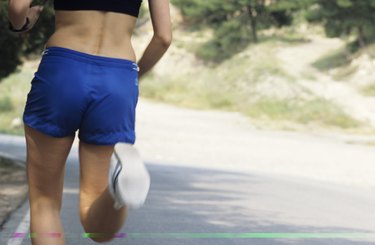
Running, whether sprinting, long distance or a combination, gets you fit in various ways. It builds cardiovascular strength, tones your legs, helps with stress relief and burns up to 1,000 calories an hour. The latter quality makes it useful in weight-loss regimens. Some people, however, actually wind up with bigger butts despite running, a function of their genetic tendencies, the types of running they perform and their diets.
Hill Running
Video of the Day
When you run uphill, your thigh rises higher than it does when you scoot along on flat ground, creating an unusually wide angle with the horizontal. In addition, running uphill requires a greater strength of push-off from the ground than does running on the flats. As a result, you invoke your gluteal muscles, a set of three large, paired muscles in your butt, to a much greater degree than you normally do, especially when doing repeat sprints up a short, steep hill as opposed to doing slower, longer runs over hilly terrain. The result can be a more pronounced rear.
Video of the Day
Sprinting
Sprinting is kinetically similar to hill running in that it requires a very strong push-off and the knees rise higher than they do during jogging or even fast-paced distance running. Elite sprint athletes often have bubble butts. According to the physique-oriented website Waist, Hips & Thighs, doing repeat sprints using starting blocks is the best way to build the gluteal muscles.
Caloric Overcompensation
Some people who take up running specifically to lose weight actually wind up gaining weight, and the hips and butt are the usual site of this gain, especially in women. People who start running to trim down may already be prone to overeating, and some mistakenly believe that they can eat whatever they want because they are now exercising heavily. For most people, running burns fewer than 100 calories per mile, so even running three miles a day only allows for the discretionary calories contained in an extra bagel. Track your food intake carefully after you begin running to stave off the bubble-butt phenomenon.
Alternatives
If you're hoping to avoid the bubble butt that paradoxically appears on some people after they take up running, focus on long, easy mileage rather than on short, intense bursts of speed. Long-distance running at moderate intensity of 60 to 80 percent of your maximum heart rate burns a lot of fat without the anabolic, or muscle-building, effect caused by higher-intensity work. It is also helpful to ensure that you are burning more calories than you eat; keeping a food journal can help in this regard.